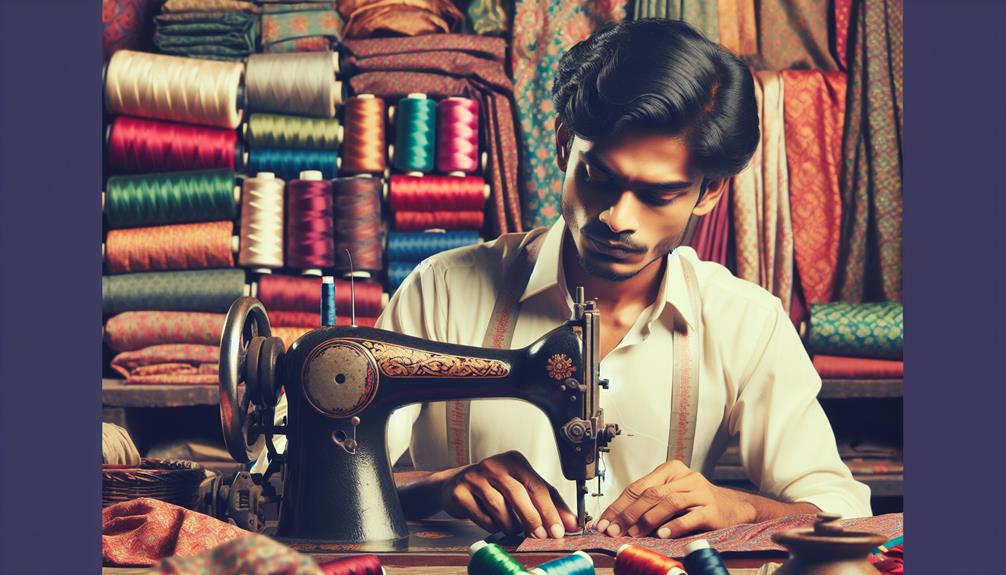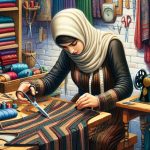Have you ever wondered what a male seamstress is called?
The world of sewing and crafting is vast, with various terms and titles for those skilled in working with fabrics.
From the classic 'Tailor' to the more modern 'Fashion Designer,' there are several names for men who excel in the art of stitching and garment construction.
But what about the less common titles like 'Sewist' or 'Fabric Artisan'?
Let's unravel the mystery behind these intriguing monikers and explore the diverse roles of men in the domain of sewing.
Table of Contents
Key Takeaways
- Male seamstresses are known as seamsters or tailors for men.
- They blend traditional techniques with modern trends in men's fashion.
- Male seamstresses challenge gender roles and stereotypes in the industry.
- Their expertise lies in precision stitching, hemming, and hand-sewing for men's clothing.
Male Seamster
As a male seamster, I take pride in crafting garments with precision and skill, ensuring each piece fits perfectly. Over the years, the male seamster style has evolved, blending traditional techniques with modern trends to create unique and stylish clothing. Seamsters, like myself, focus on the intricate details of garment construction, paying close attention to stitching, fitting, and fabric selection.
When comparing seamsters to tailors, the techniques employed may vary slightly. Seamsters typically work on a broader range of clothing items, including casual wear, suits, and even costumes. Our approach involves a mix of machine and hand sewing, utilizing both methods to achieve the desired outcome. Tailors, on the other hand, often specialize in formal attire, such as suits and formal dresses, and may rely more heavily on hand sewing techniques for a refined finish.
As a male seamster, I embrace the challenge of merging traditional craftsmanship with contemporary design, creating garments that reflect both quality and style in every stitch.
Tailor
As we explore the world of tailoring, it's fascinating to ponder the evolution of gender-neutral terms in this traditional male-dominated occupation.
The profession of a tailor has long been associated with men, but as societal norms shift, we see a change in the gender landscape of this craft.
It's intriguing to examine how tailoring has been impacted by changing perceptions of gender roles and the breaking down of traditional stereotypes.
Gender-Neutral Term
Tailors, traditionally referred to in gender-specific terms, are now commonly recognized by the gender-neutral term 'seamstress.'
- Gender Neutral Fashion Trends: Embracing gender-neutral terms like 'seamstress' aligns with the inclusive movement in fashion.
- Male Seamstresses Breaking Gender Stereotypes: Male seamstresses play a significant role in breaking gender stereotypes within the tailoring industry.
- Professional Evolution: The shift towards gender-neutral language reflects the evolving nature of professions like tailoring, emphasizing skills and artistry over gender distinctions.
This change not only reflects a more inclusive approach but also celebrates the diverse talents and contributions of individuals regardless of gender. As the industry progresses, using terms like 'seamstress' promotes equality and respect among all professionals in the field.
Traditional Male Occupation
Breaking away from traditional gender norms, the tailoring industry has long been perceived as a male-dominated field. Male tailoring traditions and cultural influences have historically shaped the craft, with renowned male tailors setting high standards.
Today, challenges persist for male seamstresses who confront gender stereotypes in the industry. Breaking into a profession often associated with women, male tailors face biases and preconceptions. However, their presence is gradually reshaping perceptions, highlighting that skill and creativity transcend gender.
Tailoring Profession Gender Norms
Challenging traditional gender norms, the tailoring profession showcases a blend of skill and creativity that transcends stereotypes.
Key Points:
- Gender Equality in Tailoring Industry: In today's world, both men and women excel in the tailoring profession, demonstrating that skill and talent know no gender boundaries.
- Breaking Stereotypes in Fashion Design: Tailors are reshaping the fashion industry by pushing the boundaries of traditional gender roles and introducing innovative designs that cater to a diverse clientele.
- Crafting a New Narrative: By embracing diversity and inclusivity, tailors are revolutionizing the industry, proving that passion and proficiency are what truly matter in the art of tailoring.
Sewist
Sewing as a craft has evolved over time, with modern practitioners often referring to themselves as sewists. As a male sewist, I find joy in breaking traditional gender norms associated with sewing and embracing this art form. Male sewists play a significant role in shaping modern fashion trends by bringing unique perspectives and creativity to the sewing community.
—
| Sewing Techniques | Gender Roles |
|---|---|
| Quilting | Challenging norms |
| Tailoring | Breaking stereotypes |
| Embroidery | Promoting inclusivity |
| Pattern making | Crafting new narratives |
—
Engaging in sewing allows me to explore various techniques such as quilting, tailoring, embroidery, and pattern making. Through these skills, I challenge gender roles by demonstrating that sewing is a craft open to everyone, regardless of gender. As male sewists continue to make their mark on the fashion industry, they contribute to the ever-evolving landscape of modern fashion trends.
Garment Maker
Exploring the art of creating garments as a male seamstress has allowed me to dive into the intricate world of garment making. It's a craft that demands precision, creativity, and attention to detail. Here are three key aspects I've come to appreciate in garment construction through my journey:
- Pattern Making: Garment making starts with translating design ideas into precise patterns. Understanding how to draft patterns tailored to individual measurements is fundamental to achieving a perfect fit. It involves intricate calculations and a keen eye for proportions.
- Sewing Techniques: Mastering various sewing techniques is essential in garment construction. From basic stitches like straight stitch and zigzag to more advanced techniques like understitching and French seams, each plays a crucial role in creating well-constructed garments. These techniques enhance the durability and aesthetics of the final piece.
- Finishing Touches: Attention to detail during the finishing stages elevates a garment's quality. Techniques like hemming, seam finishing, and adding closures like zippers or buttons give a polished look to the final creation. It's in these finishing touches that the true craftsmanship of a garment maker shines through.
Fabric Artisan
As a male seamstress delving into the land of fabric artisanry, I endeavor into a world where creativity intertwines with textile mastery. Being a textile craftsman allows me to explore innovative techniques that push the boundaries of traditional fabric manipulation. I see myself not just as a seamstress but as an artisanal fabric manipulator, constantly adapting to modern trends and creating pieces that resonate with contemporary aesthetics.
| Skills | Tools | Techniques |
|---|---|---|
| Precision cutting | Sewing machine | Embroidery |
| Pattern making | Serger | Quilting |
| Draping | Iron | Appliqué |
In my journey as a fabric artisan, I aim to merge the rich history of textile craftsmanship with the demands of today's fashion landscape. By blending traditional skills with a touch of modernity, I aim to craft pieces that not only showcase my expertise but also speak to the ever-evolving world of design.
Couturier
As a couturier, my focus is on creating gender-neutral fashion that transcends traditional boundaries. I specialize in tailoring bespoke pieces for men, bringing a fresh perspective to men's fashion.
With a keen eye for detail and a flair for design, I aim to cater to the modern man seeking unique, well-crafted garments.
Gender-Neutral Fashion Designer
Becoming a Gender-Neutral Fashion Designer in the world of haute couture has opened up new avenues for creative expression and inclusivity.
- Unisex Clothing Trends: Designing pieces that transcend traditional gender norms allows for a broader audience to connect with my creations.
- Non-Binary Fashion Design: Crafting garments that celebrate fluidity and individuality is at the core of my design philosophy, catering to those who seek pieces outside the confines of binary fashion.
- Inclusive Runway Shows: Showcasing collections on diverse models of various gender identities is essential to promoting acceptance and representation within the fashion industry.
Creating gender-neutral fashion isn't just about clothes; it's a movement towards a more inclusive and diverse future in fashion.
Tailor for Men
Being a tailor for men allows me to craft custom garments that perfectly suit each individual's style and preferences. Staying updated on men's fashion trends is crucial to offer the latest styles in bespoke tailoring. Male seamstress training has equipped me with the skills needed for pattern making, ensuring each piece fits flawlessly. Understanding the nuances of men's clothing and the importance of proper fit is essential in my role. Through attention to detail and a deep understanding of fabric and design, I create tailored pieces that exude sophistication and style. Combining traditional techniques with modern trends, I strive to deliver garments that not only look exceptional but also make the wearer feel confident and stylish.
| Key Skills | Description |
|---|---|
| Men's Fashion Trends | Stay updated to offer the latest styles in bespoke tailoring |
| Bespoke Tailoring | Craft custom garments to suit individual style and preferences |
| Male Seamstress Training | Equipped with skills for precise pattern making |
| Pattern Making | Ensure each piece fits flawlessly through precise pattern making |
Men's Wear Specialist
Crafting bespoke menswear as a couturier involves a meticulous attention to detail and a deep understanding of the nuances of men's fashion.
- Men's Fashion Trends: Staying abreast of the latest trends is important to creating contemporary pieces that resonate with clients.
- Bespoke Tailoring Techniques: Mastering traditional tailoring methods guarantees that each garment is impeccably crafted to fit the client perfectly.
- Client Relationships: Building strong relationships with clients is vital for understanding their preferences and delivering personalized garments that exceed expectations.
As a men's wear specialist, I take pride in blending the art of tailoring with a keen eye for design, making sure that each piece I create not only reflects current fashion trends but also embodies the timeless elegance of bespoke craftsmanship.
Stitcher
As a stitcher, my role is to meticulously sew together pieces of fabric to create beautifully crafted garments. Mastering stitcher techniques is important in the world of male fashion, where attention to detail is paramount. Understanding the nuances of seams, hems, and finishes is essential for creating impeccable men's clothing that aligns with current trends.
—
| Stitcher Techniques | Male Fashion |
|---|---|
| Precision in Seam Finishes | Tailored Suits |
| Expertise in Hemming | Classic Dress Shirts |
| Proficiency in Seam Placement | Trendy Streetwear |
| Skill in Hand-stitching | Modern Casual Wear |
—
Clothier
In the world of male fashion, my role as a clothier is to expertly curate and style garments that reflect the latest trends and showcase individual flair.
- Male clothiers' fashion sense: As a male clothier, I stay attuned to the ever-evolving fashion landscape, ensuring that my creations not only align with current trends but also push boundaries to set new ones.
- Seamster's role in the modern fashion industry: Seamsters play a vital role in the modern fashion industry by bringing together the artistry of traditional tailoring with contemporary design elements. We blend classic techniques with innovative approaches to create garments that resonate with today's fashion-forward clientele.
- Crafting unique pieces: Every garment I craft tells a story. From the initial concept to the final stitch, I pour my creativity and skill into each piece, ensuring that it not only fits impeccably but also exudes a sense of individuality and sophistication.
As a clothier, I enhance men's fashion by infusing it with creativity, precision, and a touch of sartorial magic.
Dressmaker
Let's unravel the art of dressmaking through the lens of male seamstresses.
From intricate tailoring techniques to the unique skills male dressmakers bring to the craft, we'll explore the history and evolution of this fascinating profession.
Get ready to discover the secrets behind the stitches and styles that have shaped the world of male dressmaking.
Tailoring Techniques Explained
Exploring the art of tailoring from a dressmaker's perspective reveals the intricate techniques behind creating well-fitted garments.
- Sewing techniques: Mastering various stitches like the backstitch for important or the slip stitch for invisible hems is important for impeccable tailoring.
- Innovative designs: Experimenting with draping, pleating, or fabric manipulation techniques can result in unique and avant-garde garment creations.
- Tailoring tools: Understanding the functions of tools such as shears, measuring tapes, and tailor's chalk is essential for precise garment construction.
Delving into these aspects not only enhances the quality of the final piece but also elevates the craftsmanship of a dressmaker to new heights.
Male Dressmaker Skills
Mastering the essential skills of a male dressmaker involves precision, creativity, and a keen eye for detail. As a male dressmaker, honing techniques specific to the craft is important. Understanding traditional gender norms in tailoring while also pushing boundaries with innovative designs is a delicate balance to strike.
Male dressmakers must excel in pattern-making, fabric selection, and garment construction to create pieces that seamlessly blend tradition with modern aesthetics. Embracing a meticulous approach to measurements and fittings is fundamental to guarantee a perfect fit for every client.
Additionally, staying updated on the latest trends and techniques in male dressmaking is essential to continually refine one's skills and stay ahead in the ever-evolving world of fashion.
History of Male Seamstresses
The historical accounts of male seamstresses, commonly known as dressmakers, reveal a fascinating narrative of craftsmanship and creativity in the domain of fashion.
- Male seamstresses in ancient civilizations brought their skills to royal courts, creating intricate garments for nobility and elite members of society.
- Evolution of male seamstress roles in modern society has seen a shift towards gender-neutral terms like tailor or fashion designer, breaking traditional stereotypes.
- The resilience and artistry of male dressmakers have persevered through changing times, contributing to the rich tapestry of fashion history.
Fashion Designer
As a fashion designer, my creativity knows no bounds when it comes to crafting unique and stylish garments. I believe that fashion is a powerful form of self-expression, and as a male designer, I'm passionate about pushing boundaries and breaking gender norms in the industry. Male seamstress empowerment is essential in challenging stereotypes, and I take pride in being part of this movement.
In today's fashion world, collaborations between designers are becoming increasingly common. These partnerships not only showcase male creativity but also open up new avenues for innovation and inspiration. Working with other designers allows for a fusion of diverse ideas and styles, resulting in truly exceptional collections.
Being a fashion designer isn't just about creating clothes; it's about making a statement and influencing culture. By embracing my role as a male designer, I hope to inspire others to pursue their passion for fashion, regardless of gender stereotypes. Fashion is a limitless canvas, and I'm committed to using my creativity to make a difference in the industry.
Frequently Asked Questions
Can a Male Seamstress Be Referred to as a Tailor?
Yes, a male seamstress can be referred to as a tailor. Gender stereotypes in sewing should not limit word choices. Embracing equality in this craft means recognizing skill over traditional roles and using gender-neutral terminology.
Do Male Seamstresses Have Different Skills or Techniques Than Female Seamstresses?
In the domain of sewing, gender stereotypes often influence perceptions of skill. However, both male and female seamstresses can excel in various techniques and garment construction. The key lies in individual dedication and practice.
Are There Any Famous Male Seamstresses in History?
Male seamstress pioneers have left lasting legacies in the fashion world. Their contributions are invaluable, shaping the industry with innovative techniques and designs. From unknown talents to celebrated icons, male seamstresses have made significant impacts throughout history.
How Long Does It Typically Take for a Male Seamstress to Complete a Garment?
Completing a garment as a male seamstress varies based on complexity, but my efficiency is honed through tailoring techniques. Attention to detail and skill help me deliver quality work in a timely manner.
Are There Any Specific Challenges That Male Seamstresses Face in the Industry Compared to Females?
Facing gender stereotypes and discrimination, male seamstresses encounter challenges in the industry. Wage gap and limited career advancement opportunities are common issues. Overcoming biases is essential for equality and inclusivity in the field.
- Tetron Fabric for Marine Applications: Durability and Use Cases - June 18, 2025
- Tetron Fabric for Outdoor Furniture: Weather Resistance and Care - June 18, 2025
- Tetron Fabric for Wall Coverings: Style and Application Tips - June 18, 2025







